The Physical Challenge of Fiddling
In this lesson, I’ll show you how to practice well and overcome the physical challenges of fiddling. It’s a long article so I’ll give you the take-home message up front:
The best way to overcome physical challenges is to break down complex problems into simpler practice tasks.
There are three main challenges you’ll face on your fiddle journey:
- Practice Challenge
- Physical Challenge
- Emotional Challenge
So far I’ve talked about the Practice Challenge and how that can be overcome by removing resistance to daily practice. I know you can do this if you create a good practice environment and commit to at least two minutes a day. Establishing a consistent practice habit is the first and most important step to learning fiddling (or any skill).
Once you’ve made practice a regular part of your life, the next step is to learn how to practice well so that you can overcome the physical challenges of fiddling.
After 25 years of giving in-person lessons, answering emails, comments and forum posts, I’ve identified common physical challenges that my students have dealt with:
- Getting the form right for bowing and fingering
- Getting a nice sound with the bow
- Playing in tune
- Overcoming fatigue and muscle pain
- Playing at a steady tempo
- Remembering to do all these things
- Once you’ve remembered all the things, doing them all at the same time 🤯
It can be overwhelming! Here are five actionable strategies that will help you to learn any tune on any instrument.
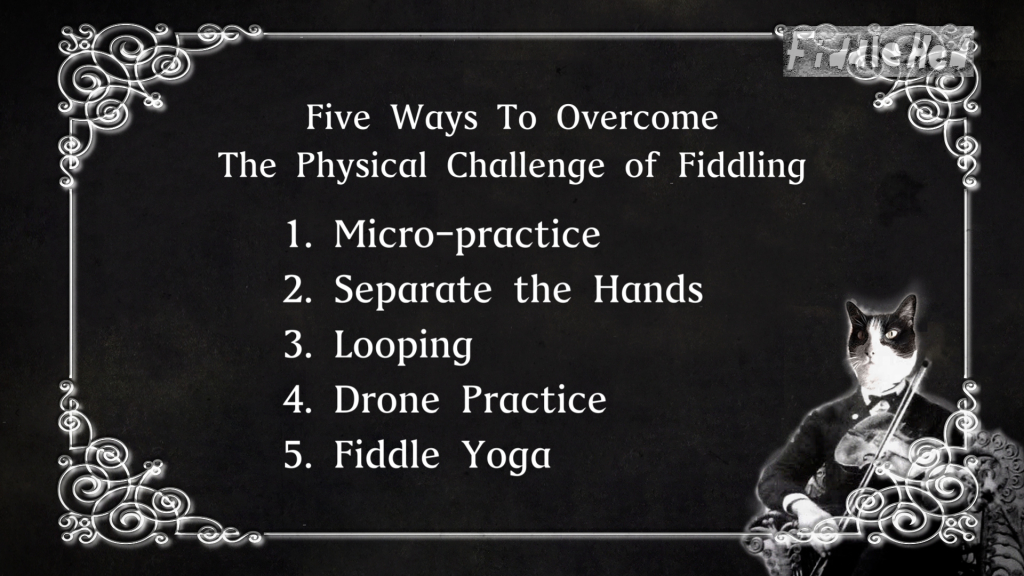
I’ll now go into more detail, giving you an action step for each strategy.
1. Micro-practice
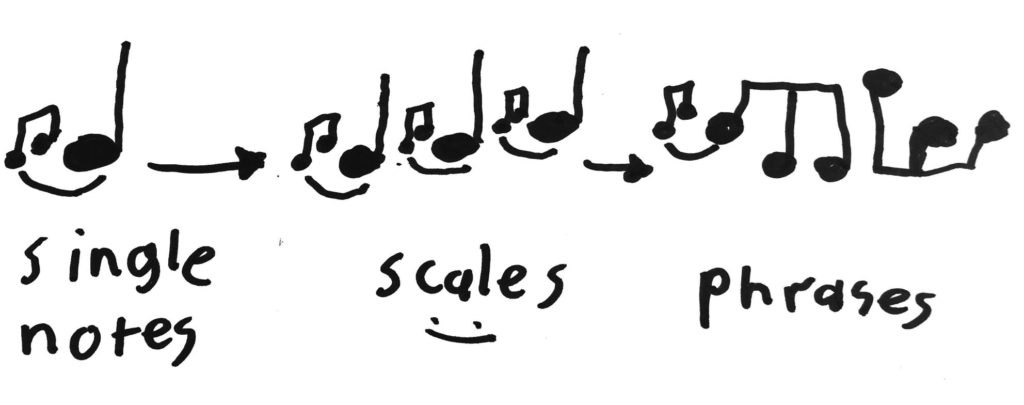
Micro-practice is the process of breaking larger, complicated tasks (like a whole tune) into smaller pieces that are the perfect level of challenge. You learn to master each little piece of a tune. Or you break a complex skill (like adding double stops to scales) into sub-skills that can be easily practiced.
OK. Let me pause. If you learn nothing else from me but micro-practice, if you don’t read any more of these emails or watch any more FiddleHed videos, then your time will have not been wasted. Seriously. After you establish a daily practice habit, you need to do micro-practice in order to really learn (anything).
Say you’re learning Arkansas Traveller. If you always charge through the whole thing, it will be a struggle. You’ll be practicing the easy parts as much as the difficult parts. In this way, your progress will be slow, because you never give those difficult parts the extra attention they need.
The power of micro-practice (also known as “Deliberate Practice”) is that you learn to isolate each challenge of a tune. That way, you’ll see an improvement in those parts.
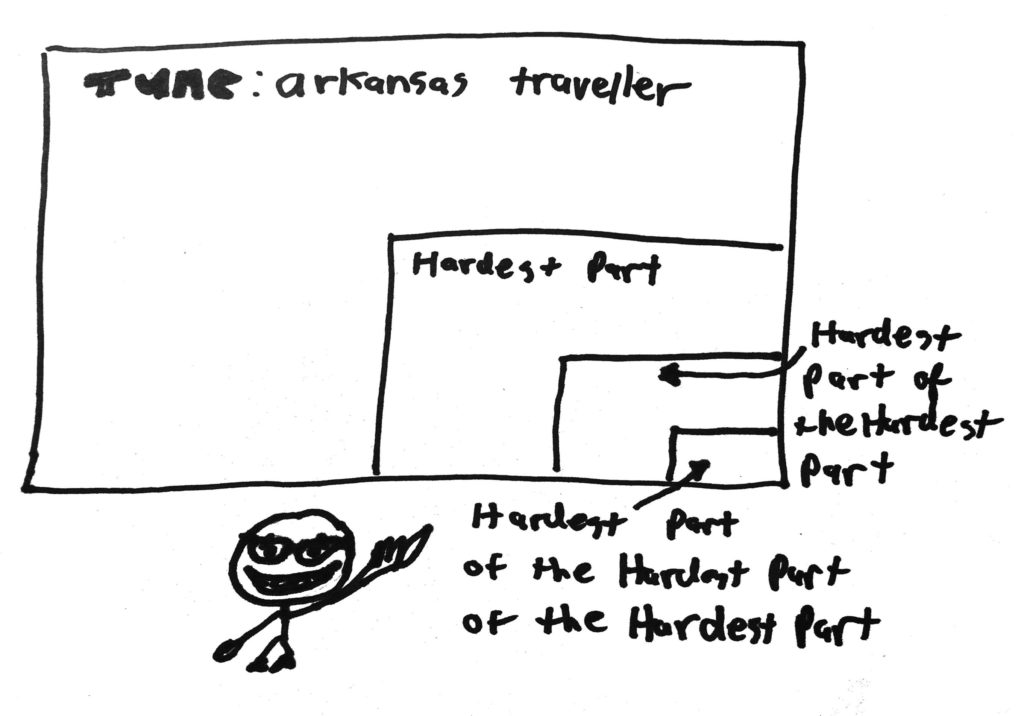
Ask yourself, what’s the hardest part of a tune? Then ask yourself, “What’s the hardest part of that hardest part?” Once you’ve mastered these small bits, then assemble them into bigger pieces. And before you know it, you can play the whole tune.
Let’s use Arkansas Traveller as an example. A lot of students find the fourth quarter of the A part to be challenging. So instead of always playing the whole A part, focus your time and energy on that difficult part:
Fourth quarter: A3-2-3-0-1-3-0-D3-2-0-1-2-0

Next we break down that difficult part into smaller parts that aren’t as difficult. So for most folks, the hardest part of this hardest part is A1-3-0-D3. Now practice those four notes.
A1-3-0-D3
You might discover that the hardest part of this hardest part is going from open A0 (open A string) to D3. Now just practice that.
A0-D3
2. Separate the hands
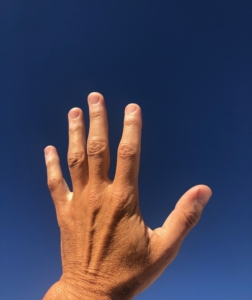
When you learn an instrument, you have to do some serious multi-tasking.
A simple way to work on hard parts in music is to separate your hands. I mean, keep them attached to your arms and everything…😛 If you find that you’re struggling, simply focus on one hand at a time.
Break down problems according to what each hand is doing. This is actually a form of micro-practice (your new super-power). You’re breaking down complex problems into simpler practice tasks. (Wait, did I already mention that this was important? 🤓)
Action Step: Right, Left, Synchronize
D3-1-1-A1-D1-1

- Focus on the right hand by just bowing the part on the open strings: A0-D0-0-A0-D0-0. Rest your left hand in beginner’s position on the fiddle.
- Next, focus on the left hand. Set down the bow and just pluck out the left-hand fingering: D3-1-1-A1-D1-1. Plucking is easier than bowing. So you can devote more mental resources to learning the left-hand fingering.
- Integrating step: Slowly play the first three notes with bowing and fingering. This combines the left and right hands in a manageable step. Once you can do that, you’re well on your way to doing it with larger and larger pieces.
3. Looping
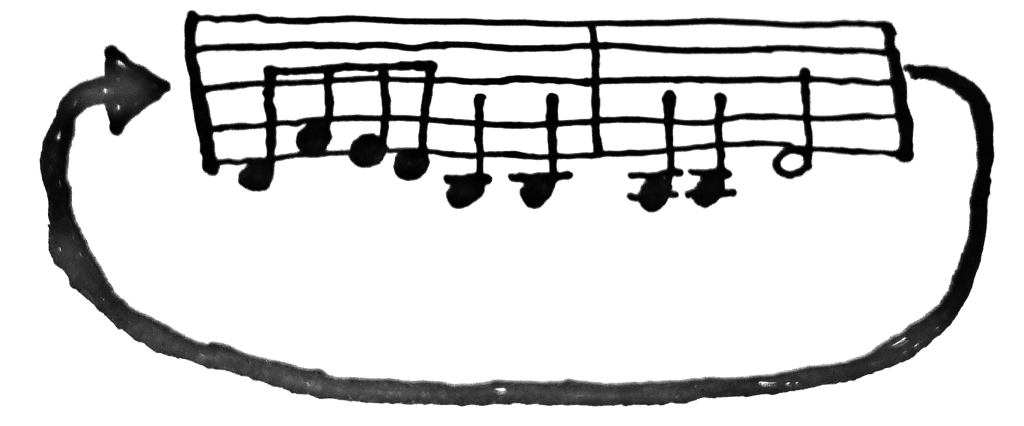
A lot of students ask, “How do I make my fiddling sound more like fiddling?” Looping is the answer.
The basic idea of looping: instead of playing a tune all the way through, loop on a small piece until it starts to sound like music.
It’s hard to achieve musical flow for an entire piece. You find that you constantly stop and start as you hit difficult spots. But if you learn one little piece and then loop on it, you’ll start to feel the deep satisfaction of making music.
A part, first quarter: A1-2-1-0 | D2-1-2

D2-2-A0-0

Once you figure out that sub-piece, you can loop that! And once you get the sub-piece, return to looping on the first quarter.
4. Drone practice
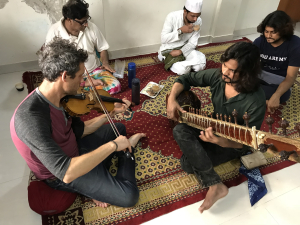
I discovered drone practice when I got into Indian music. Then came a musical pilgrimage to India where I took lessons, went to concerts, met and played with other musicians.
You might be asking, “Hey Jason, what’s a drone?” A drone is a sustained reference pitch:
“OK, cool. But why should I use a drone?”
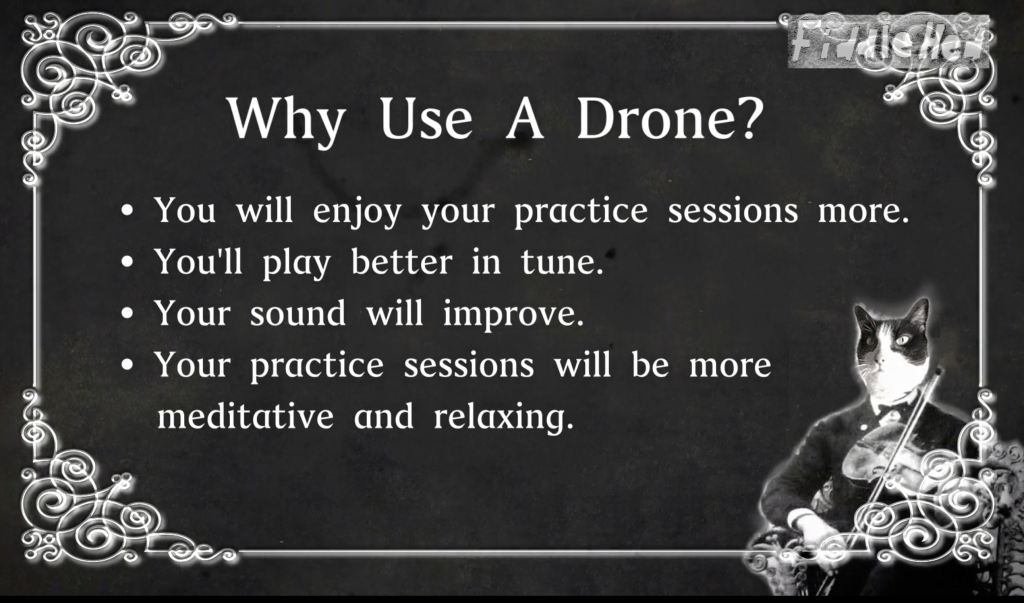
If practicing D2 (F#), use an F# drone:
Go further by practicing two-note intervals centered on a target note. So if you’re trying to play D3 (G) in tune, practice D3-A0 with a G drone.
Since the A0 is easy (an open string), using the G drone will help you to correct the tuning on D3.
5. Fiddle yoga
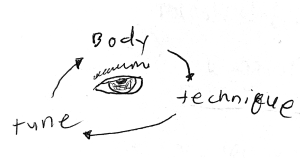
Often when I practice, I find that I’m not breathing evenly or that certain muscles are tense (like my stomach or shoulders). When I become aware of this, I try to pause what I’m doing and connect to the body using a process I call fiddle yoga.
Bring awareness to the body, breath and mind as you play. This will help you to overcome tough practice challenges and make your session more enjoyable.
This relaxes me and connects me to the joy of playing. After I make this connection, I often find that whatever “impossible” thing I was practicing isn’t that big of a deal anymore.
- Simply hold the fiddle and bow without playing. Become aware of the body, breath and mind, allowing them to relax.
- Next, bow on the open D string with a D drone. Allow yourself to enjoy the sound. Don’t seek perfection. Just make a good simple sound.
- Achieving that, take steps towards doing more complex things: a two-note interval (D0-1, D1-2, etc.) a simple scale, then a simple tune. See if you can keep that relaxed feeling through each step until you return to the current practice challenge.
Let’s sum up…

Here’s what FiddleHed Neil has to say about micro-practice:
“The way you teach by breaking down the song into part A and B and quarters is fantastic. And your patient and calm manner really helps.”
Are you ready to begin your fiddle journey? I’ll send you some free lessons tailored to your current skill level.
Click here to become a FiddleHed!
Two ways I can help you level up your fiddling
- Sign up for the FiddleHed newsletter below.
- Sign up for the Free Two-week Trial. You’ll get full access to all courses and group lessons. Plus, I’ll send you some free lessons tailored to your current skill level.
Thanks for being here 🙏
Return to Fiddle Questions >>
Leave a Reply
You must be logged in to post a comment.

Thank you, for being so helpful and supportive of what is obviously fiddlers at large,but I especially thank you for being even more helpful than I could have imagined to this was wannabe soon will be fiddler. And I am on a free trial. You are great and I appreciate the hard work you have done to help. Really get a lot out of your taking the time to email helpful advice I did not find a website with lessons I found a teacher.
I really enjoyed this and got a lot out of each part. You explain things really well. I found when I did the drone on the E I could hear the E but I could also hear a higher note which turned out to be a B. Is there something wrong with my hearing or am I supposed to hear the higher note for some reason? I only hear it with the drone.
Love the drones, thanks